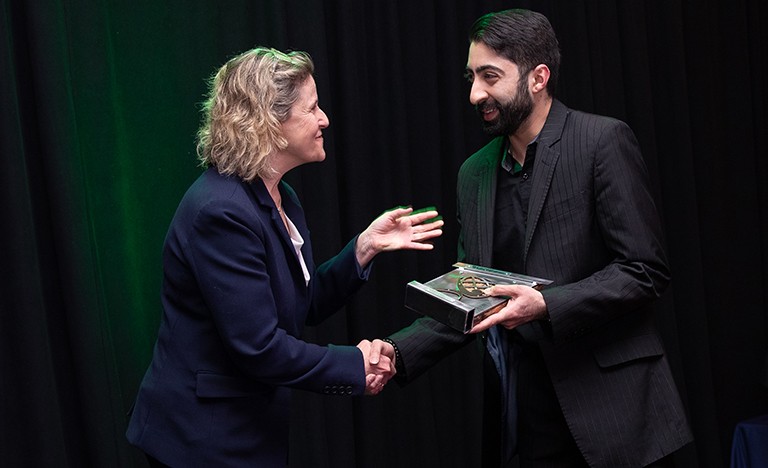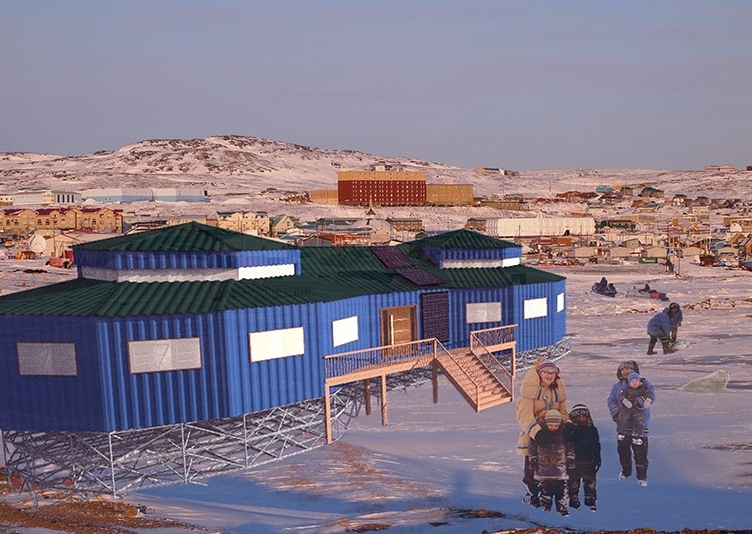Gina Cody School Capstone team places third in the Solar Decathlon building design competition
 Team member Kishan Gandhi accepting the award in Colorado.
Team member Kishan Gandhi accepting the award in Colorado.
A group of students from Concordia’s Gina Cody School of Engineering and Computer Science sought to have their Building Engineering program Capstone project address housing issues in Canada. Their resulting creation went on to make the podium at an international student building design competition.
The team’s Capstone project, called Built for the North, recently placed third in the New Housing Division of the United States Department of Energy’s Solar Decathlon. Hosted in Golden, Colorado, the international student competition brings together students from more than 20 universities across North America, Australia, India and the United Kingdom.
The contest challenges the next generation of building professionals to design and construct high-performance, low-carbon buildings powered by renewable energy.
The Concordia team is made up of building engineering undergraduate students Hannah del Rosario, Youssef El Ouarat, Kishan Gandhi, Mihail Mihaylov and Maggie Turmel. They submitted their Capstone project to the Solar Decathlon with support from Bruno Lee, associate professor of building, civil and environmental engineering.
Built for the North centres on the structure and design of sustainable housing that answers to the cultural and practical needs of the Inuit population in Iqaluit. It brings together two main themes, recycling shipping containers and integrating cultural practices, into its design.
“We chose this project once we realized the extent of the housing crisis happening in Iqaluit, as well as the impact colonialism has had on the culture of the Inuit living there,” says del Rosario. “We wanted to develop a structure that is both sustainable and respectful of their culture.”
The students designed a housing model that uses recycled shipping containers as the main structural element. They mimicked the traditional structure and shape of an igloo, as a nod to the design that was historically dominant in the region.
 A rendering of the students' design, Built for the North.
A rendering of the students' design, Built for the North.
The project also factored in spaces that would accommodate traditional cultural practices of the Inuit, including:
- cold space for outerwear storage and entrances
- cool space (around 40 F or 4 C) for sewing, hide separation and meat processing
- warm spaces like flexible living spaces, bathroom and kitchen
As the course coordinator of the building engineering Capstone, Lee intentionally set up a submission schedule for the project that coincided with the decathlons.
“I wanted my students to participate in this competition without the burden of added work,” he notes.
Pushing the envelope
“This competition motivates students to make full use of what they learn in class by applying it to their Capstone projects in a multidisciplinary way,” Lee says. “Having the opportunity to present their work on an international stage is a bonus that is very attractive for our teams.”
He notes that their ability to seamlessly integrate structural, envelope and HVAC systems into a unique solution allowed the Built for the North team members to push their own boundaries and take home third place at the solar decathlon.
Lee adds that the programs offered at the Gina Cody School prepare students to tackle these types of complex projects successfully.
Learn more about Concordia’s Gina Cody School of Engineering and Computer Science.
Explore the Department of Building, Civil and Environmental Engineering.


